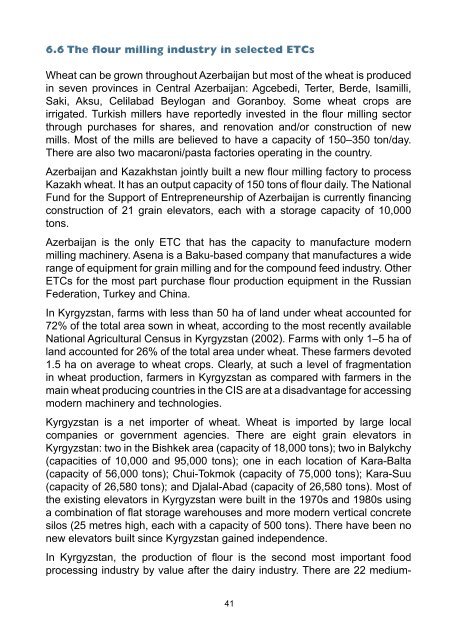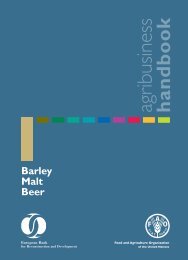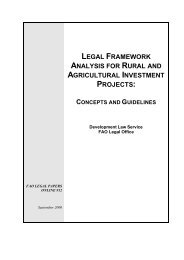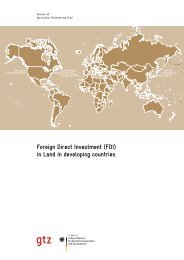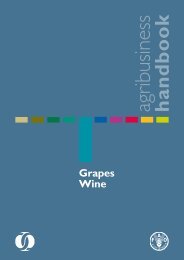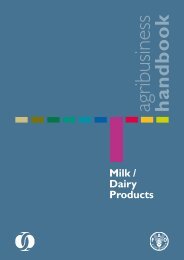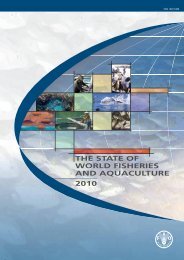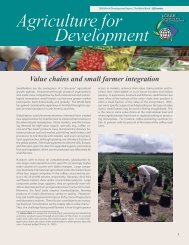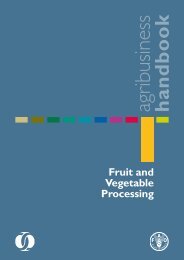Wheat Flour
Wheat Flour
Wheat Flour
Create successful ePaper yourself
Turn your PDF publications into a flip-book with our unique Google optimized e-Paper software.
6.6 The flour milling industry in selected ETCs<br />
<strong>Wheat</strong> can be grown throughout Azerbaijan but most of the wheat is produced<br />
in seven provinces in Central Azerbaijan: Agcebedi, Terter, Berde, Isamilli,<br />
Saki, Aksu, Celilabad Beylogan and Goranboy. Some wheat crops are<br />
irrigated. Turkish millers have reportedly invested in the flour milling sector<br />
through purchases for shares, and renovation and/or construction of new<br />
mills. Most of the mills are believed to have a capacity of 150–350 ton/day.<br />
There are also two macaroni/pasta factories operating in the country.<br />
Azerbaijan and Kazakhstan jointly built a new flour milling factory to process<br />
Kazakh wheat. It has an output capacity of 150 tons of flour daily. The National<br />
Fund for the Support of Entrepreneurship of Azerbaijan is currently financing<br />
construction of 21 grain elevators, each with a storage capacity of 10,000<br />
tons.<br />
Azerbaijan is the only ЕТС that has the capacity to manufacture modern<br />
milling machinery. Asena is a Baku-based company that manufactures a wide<br />
range of equipment for grain milling and for the compound feed industry. Other<br />
ЕТСs for the most part purchase flour production equipment in the Russian<br />
Federation, Turkey and China.<br />
In Kyrgyzstan, farms with less than 50 ha of land under wheat accounted for<br />
72% of the total area sown in wheat, according to the most recently available<br />
National Agricultural Census in Kyrgyzstan (2002). Farms with only 1–5 ha of<br />
land accounted for 26% of the total area under wheat. These farmers devoted<br />
1.5 ha on average to wheat crops. Clearly, at such a level of fragmentation<br />
in wheat production, farmers in Kyrgyzstan as compared with farmers in the<br />
main wheat producing countries in the CIS are at a disadvantage for accessing<br />
modern machinery and technologies.<br />
Kyrgyzstan is a net importer of wheat. <strong>Wheat</strong> is imported by large local<br />
companies or government agencies. There are eight grain elevators in<br />
Kyrgyzstan: two in the Bishkek area (capacity of 18,000 tons); two in Balykchy<br />
(capacities of 10,000 and 95,000 tons); one in each location of Kara-Balta<br />
(capacity of 56,000 tons); Chui-Tokmok (capacity of 75,000 tons); Kara-Suu<br />
(capacity of 26,580 tons); and Djalal-Abad (capacity of 26,580 tons). Most of<br />
the existing elevators in Kyrgyzstan were built in the 1970s and 1980s using<br />
a combination of flat storage warehouses and more modern vertical concrete<br />
silos (25 metres high, each with a capacity of 500 tons). There have been no<br />
new elevators built since Kyrgyzstan gained independence.<br />
In Kyrgyzstan, the production of flour is the second most important food<br />
processing industry by value after the dairy industry. There are 22 medium-<br />
41


